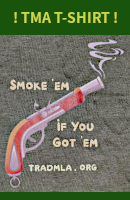Hi fellas, My name is Rob and I also have a Indian Baker (posted here a couple of times too). I hope you don't mind me chiming in here! I went for a shoot yesterday for the first time in a long while. Decided to go with a new patch material and work up a load for it. I have some light, tight weave, "canvassy" kind of material that measures .018 (where the micrometer stops at) and crushes down to .009 or .010. It was lubed with a dip in straight shortening and a squeeze to get rid of any excess. I wrapped these around cast .610 balls and I was pleasantly surprised. Now I have to mention that the barrel is a 1-120 original style barrel from Ed Rayl and as such is inherently less accurate though historically correct. As there are very few references for actual baker accuracy around I use the target that is illustrated in a number of books showing a figure of a man shot at by Baker himself from the standing (presumably unsupported) at 200 yds. All these rounds are within a group measuring some 3' 6" high by some 18" wide. Also there is a quote from the "Military Flintlock" book by DW Bailey stating that a 3rd Class marksman (the best) had to shoot 4 of 6 rounds either in to the figure target or a 15" Circle at 200 and 300 yds. So it is with this information that I formulate the standard that my rifle should shoot to. So, a nice sunny day with little wind. I started at 50 metres to group and then zero. I had recently added a new sight modification to the rear sight in so much as a small piece of brass added to the rear of the rearsight to lessen the considerable "vee" of the one that came with the rifle.

Made the sight picture much more fine and easier to use. The only thing is it shoots way high now.... more on that later. I started with 60 grains FFg and made leaps or 5 gr up to 90 shooting five round groups. Then I did the same using a 20 gauge lubed fibre wad under the patched ball and this made the group considerably higher as a result of the greater pressure created moving more mass out the barrel I guess. The rifle defiantly felt like it was kicking just a bit differently and its report had a much sharper element to it. The wad idea came around when I was using thinner patch material that was burning out with greater loads and I found that it had the added benefit of lubing and cleaning the barrel to the point of being able to fire 50 or so rounds in a row with little or no fouling (except in the lock area of course). I found the best group of the day at 50 metres was 2 1/2 inches measured centre to centre with 3" group readily reproduced.

This was done with 90 grs FFg with no wad. So not amazing by any modern standards but I took this as an acceptable standard to zero for deflection and brought the groups into line with a couple of taps of the foresight. Out to 100. The groups did not drop as significantly as I was expecting (presumably due to the 90 gr charge...) and all were about the same 8" or so high..... (ultimately I will have to lower the rearsight to bring the groups down when the final zero and load confirmation take place.....soon) I shot groups that measured 6" to 6 1/2".

This would seem to correspond with simple math saying the 3" at 50m will be 6" at 100m, eh? So to take that a step further say out to 200 I could expect that I could shoot a 12" group at 200m and an 18" group at 300m...... And when I compare that to the references it all seems to match up...... I should certainly be able to hit a full size figure target at 200 and with out too much of a stretch hit a 15" circle at 300. Well this is all very exciting to me, what with being able to reproduce the kind of accuracy expected of a marksman of the 95th or 60th..... No its not modern "ass out of a gnat" accuracy but it is certainly up there with the early 19th century's version of it......... What a great day.....
Thanks,
Rob




